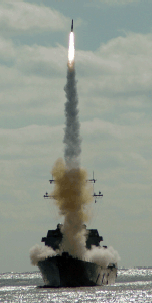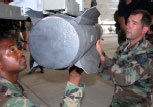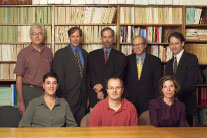 |
|
 |
 |
 |
 |
|
The Nuclear Weapons Crisis
In the aftermath of the 9/11 attacks on New York City and Washington, DC, there were significant efforts in Congress and by the Administration to increase budgets for homeland security and new weapons systems. Many Americans accepted the “need” for massive build-ups in a previously abandoned missile defense system, for the development of new nuclear weapons, and a war in Iraq as well as Afghanistan in order to ensure security.
The Bush Administration, with help from a conservative Congress, requested funds for a Robust Nuclear Earth Penetrator (“bunker buster”) and for study of advanced concept weapons (“new nukes”). The Administration withdrew from the Anti-Ballistic Missile Treaty, put in its place the toothless Moscow Treaty, and began to construct a missile defense system in Alaska. The Defense and Energy Departments requested billions in funding for missile defense and other nuclear weapons systems. The President's national security policy opened the door to tactical and pre-emptive use of nuclear weapons. In reaction, North Korea announced it possessed nuclear weapons and other countries indicated a commitment to developing them. The Nuclear Nonproliferation Treaty - the bedrock upon which disarmament has been based - appeared close to collapse.
And, as if to add insult to injury, the peace and security field suffered the loss of one-third of its annual funding at a time when it could least afford the shortfall.
The Community Rises to the Challenge
Despite the constant drumbeat about an “Axis of Evil” and the necessity of “homeland security,” long-time arms control and nuclear disarmament organizations and individuals remained committed to the power of peace. They believed in international treaties and the need to disarm countries that had or could acquire the means to develop nuclear weapons. These groups - ranging from think tanks to inside-the-Beltway lobbyists to local grassroots groups - were determined to be voices of reason in a time of terror and hype. They also realized the immense challenge of making their voices heard given the loss of significant funds.
While the initial reaction of some nonprofit organizations was to work harder to get a larger share of a smaller pie, they soon recognized the need to re-think how the peace and security field operated. In 2002, a group of foundations and nonprofit organizations instituted the Peace and Security Initiative (PSI), a unique collaboration through which funders and grant recipients worked as peers to determine what the community needed in order to be successful.
In 2004, PSI members selected and implemented targeted campaigns to address major crises. Initial campaigns focused on Iraq and the need for great international engagement, eliminating possible development of new nuclear weapons, and safeguarding nuclear materials. PSI encouraged nonprofit groups to develop common strategies and tactics to tackle each issue and brought communications and fundraising skills to members. This community-wide effort led to some modest successes as new coalitions formed around specific issues and progress was made.
Among organizations that lobby on Capitol Hill, there was great awareness of being outnumbered and outfinanced. To address the need for more lobbying power, groups such as the Union of Concerned Scientists added lobbying staff and others, including the Arms Control Association and Council for a Livable World, took leadership roles in working on a key set of issues.
Groups such as the Nuclear Weapons Working Group and the Directors Forum offered opportunities to share information and keep everyone informed about each organization's advocacy and lobbying efforts. These groups played an important role, but as voluntary efforts they lacked the ability to ensure a common agenda and strategy. Several groups accepted an invitation to work collaboratively to develop and implement a common lobbying agenda with the assistance of a full-time lobbyist funded by two foundations. That group, the Arms Control Advocacy Collaborative (AC2), has become a well-established voice of reason on arms control and nuclear disarmament advocacy issues over the past three years.
|
|
Peace is not merely a distant goal that we seek, but a means by which we arrive at that goal. We must pursue peaceful ends through peaceful means.”
• Dr. Martin Luther King, Jr., Civil Rights Leader |
|
 |


|
|
Our Contributions
We have been committed to eliminating the nuclear threat - whether from a bomb or terrorist activity - since the Foundation's inception. With our public charity status, we have always taken advantage of our ability to engage in lobbying and to fund lobbying activities to reduce this threat.
Our signature program has been the Arms Control Advocacy Collaborative (AC2). With the Ploughshares Fund, we developed this advocacy and lobbying initiative as a three-year pilot project in 2002. With Ploughshares, we funded a full-time lobbyist in Washington, DC, who has worked to advance a common agenda developed by the ten participating nonprofit organizations. The organizations received grants from us to support their overall activities. In addition to the $400,000 we provided in support of AC2 in its first years, in 2005, we made the commitment to invest another $400,000-plus in Phase II of AC2 over the next three years.
We contribute in a number of other ways to the field. In 2005, we made a substantial grant to the Ploughshares Fund for its nuclear threats re-granting program. We lobbied alongside our AC2 colleagues for elimination of funding for new nukes, missile defense, and other expensive nuclear programs. We invested our human resources in community-wide initiatives because our grant funds were limited. For example, our President & CEO has been heavily engaged in the Peace and Security Initiative (PSI), which is a partnership between funders and nonprofit organizations in the community. In addition, she worked with the Peace and Security Funders Group to help it further its mission, including efforts to bring new donors to the field.
|
|

Arms Control Advocacy Collaborative, standing: (L to R) Ivan Oelrich, Stephen Young, David Culp, John Isaacs, Daryl Kimball. Seated: (L to R) Susan Frank, Martin Butcher, Terri Lodge. Not pictured: Theresa Hitchens, Matt Martin, Chris Paine, Marie Rietmann.
|
|
 |
|
